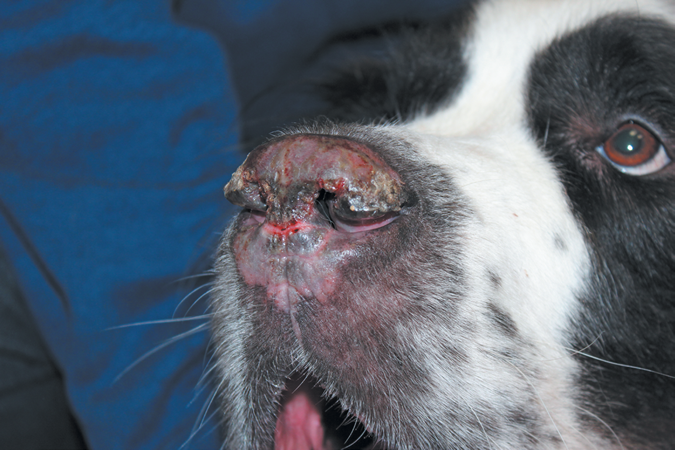Just like people, dogs can get lupus. It’s an autoimmune disease, meaning that the immune system mistakes the body’s own tissues for foreign “invaders” and starts attacking and destroying them. Two types of lupus strike our canine pets: systematic lupus erythematosus (SLE) and cutaneous lupus erythematosus (CLE). The first is much more devastating, with worse symptoms that can have life-threatening implications. The second is not as dangerous but needs to be brought under control to avoid serious complications down the line.
Diagnosing and treating systemic lupus erythematosus
Signs of systemic lupus, or SLE, can take many forms. These include lethargy, decreased appetite, lameness that might move from limb to limb, redness and thinning of skin, loss of hair, fever, muscle pain, and enlargement of the liver, spleen, or lymph nodes. Some cases, if not treated successfully, can lead to kidney failure.
Because the symptoms can mimic so many other diseases, diagnosis is “difficult and controversial,” says Tufts veterinary internist Michael Stone, DVM, who reports he comes across cases of SLE three to four times a year. “There are real criteria for diagnosis of systemic lupus in people,” he notes, “and we’ve adopted those guidelines for animals. But it’s kind of a constellation of findings. In most cases we work to confirm a case of SLE with what’s called an antinuclear antibody test — a blood test that looks specifically at cells in the immune system known to be involved with lupus. We also look for at least two different organs being attacked by the immune system.”
The good news, Dr. Stone says, is that even though SLE can be life-threatening, once diagnosed, it “can be gotten under control. Most dogs with lupus do very well,” he says.
Treatment consists of a regimen of corticosteroids. These are part of a broad category of drugs called immunosuppressants, or immune-modulating drugs. “They work to tone down the immune system,” Dr. Stone says, which keeps the dog’s body from turning on itself. The only problem is that they can have long-term side effects, including a general loss of energy and an increased propensity for infections (which makes sense since the drugs rein in the immune system).
Fortunately, dogs for whom the side effects are worse than the cure can be administered different immune suppressants, including mycophenolate, azathioprine, and cyclosporine. The veterinarian has an arsenal of treatments to try and see which works best with the fewest downsides for a particular dog.
Diagnosing and treating a common form of cutaneous lupus erythematosus
“Cutaneous” refers to the skin, and that’s where the disease takes hold. The most common form appears to be discoid lupus erythematosus, or DLE. “I have seen more DLE than other cutaneous lupus variants,” says Tufts veterinary dermatologist Ramn Almela, DVM.
The classic form of DLE most often occurs on a dog’s face, particularly the nose — the bridge of the nose and the muzzle. Dr. Almela says that “usually you can see a combination of changes, for example, crusting, ulcerations, redness, and changes in the pigmentation of the skin. Sometimes there’s bleeding and scabbing as well. And the disease can also affect a dog around the eyes and the lips,” he says — much less often, away from the face.
“It’s not the most common autoimmune disease,” he relates. “In one study undertaken at the veterinary school at Cornell University, the prevalence was 0.3 percent of total cases presented to the dermatology service,” Dr. Almela reports, or three in 1,000. “My impression is that here at Tufts we have a similar incidence. Whatever the prevalence in any given locale, by far the most predisposed breed is the German shepherd.”
Because DLE can be mistaken for certain other health problems — bacterial infections, other autoimmune infections, even cancer — diagnosis is confirmed with a skin biopsy.
Currently, the most successful approach comes in the form of treatments with a topical or systemic calcineurin inhibitor, either applied topically or administered orally. Like the drugs for SLE, calcineurin inhibitors are also immune system suppressants. (Cyclosporine is one.)
“You can apply the topical treatment in milder cases and see if you get remission,” Dr. Almela says. “If not, you go to the systemic [oral] treatment. With time, you might be able to taper the frequency with which you give the medicine, perhaps going from daily to three times a week. But you usually can’t take the dog off the drug completely. Once the pet has DLE, she generally has it for life. It occurs mostly in middle age to older dogs, starting at around age 7 through 9.”
The good news about DLE, Dr. Almela notes, is that it will not cause most dogs pain. “But you still have to treat it,” he says. “It can get worse over time, compromising the skin and allowing more ulcerations and a place for harmful bacteria or progression to cancer in rare cases.” The skin is the body’s largest organ, he points out. “It must remain protected.”






Good afternoon, my wife and I have a 5 year old German Shepherd that has recently been diagnosed with DLE Lupus. She also has EPI-and has had EPI for the past 4 years and is doing great (74 pounds). What are your recommendations for dry kibble? There are so many voices out there about grain in, grain free, etc.-what might you recommend? We currently feed Natures Logic (has millet), along with some Honest Kitchen soft, as a topper, some Royal Canin soft very low fat for her EPI, etc. Would very much appreciated your expertise, given the DLE/Lupus issue and whether we should consider a grain in or grain free diet as her main kibble staple? Many thanks….Barry Fonarow